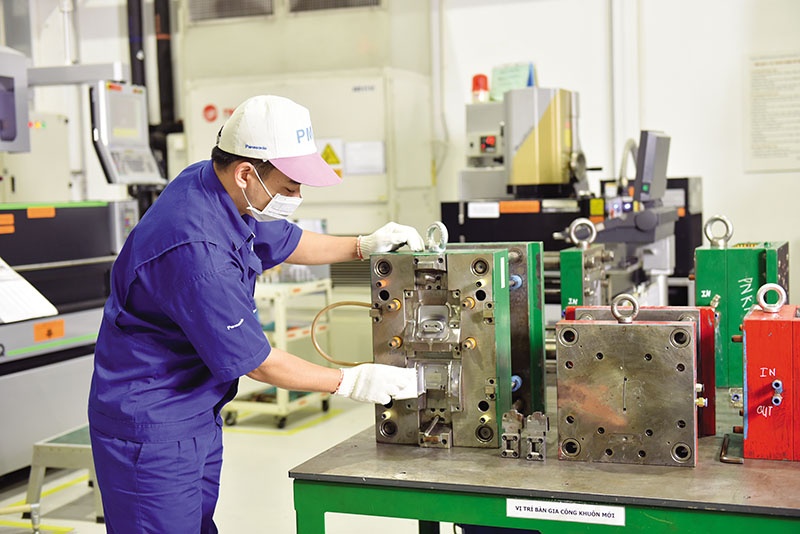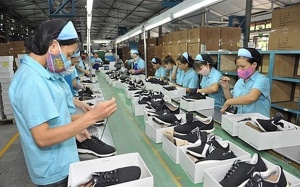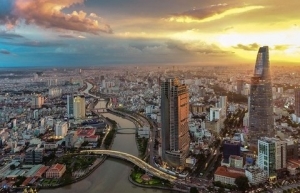Vietnam expected to remain an FDI darling over long term
 |
The latest report by Maybank indicates that Vietnam’s strengths will continue to anchor it as a preferred choice for many manufacturers over the near future.
Improving the business environment, upgrading the infrastructure, upskilling the workforce, and strengthening the links between multinational companies (MNC) and local supporting industries will help Vietnam remain competitive and an FDI darling over the longer term.
Between 2013 and 2021, South Korea has been the largest foreign investor in cumulative terms accounting for 22 per cent of total FDI pledges, reflecting South Korean conglomerates like Samsung and LG’s substantial investments in consumer electronics and appliance production. Vietnam is Samsung’s largest smartphone production base, accounting for half of its global production.
Meanwhile, Singapore is the main ASEAN investor in Vietnam and has overtaken South Korea to become the former’s top investor for two years running.
FDI pledges amounted to about $20 billion over 2020-21, more than double of South Korea’s. Singapore has poured investments into the Vietnam-Singapore Industrial Park projects, ranging from urban infrastructure and services to smart urban energy solutions.
Singapore consumer brands have built a presence in Vietnam, while venture capital funds are investing in Vietnam’s tech startups.
Vietnam was the top destination for Singapore companies considering overseas expansion in 2020, driven by bright economic prospects, a large domestic market, and an expansion of the government’s Global Innovation Alliance Network to Ho Chi Minh City in 2019.
Another notable trend is the increase in supply chain diversification from China. Over the past few months, more electronics giants such as Apple and Google have announced factory relocations to Vietnam, stung by widespread supply chain disruptions from China’s zero-COVID lockdowns and intensifying US-China geopolitical rivalry.
| "Vietnam will continue to be one of the largest beneficiaries of supply chain shifts to ASEAN, especially for 'mid-tech' assembly activities. But Vietnam does not have the production scale, workforce, and infrastructure to fully replace China as the world’s factory, and manufacturers are unlikely to completely move out of China. Nonetheless, Vietnam’s manufacturing output will nearly double even if only 1 per cent of China’s capacity is diverted to the country," said Maybank analysts. |
The report also points out that the US CHIPS act and related measures against China will help reinforce supply chain shifts to Vietnam and develop its nascent semiconductor industry.
Samsung and Synopsys have recently announced significant chip-related investments. Vietnam’s main capabilities are in the backend and lower value-added operations, but it could develop deeper expertise that allows it to transit to higher-value activities, as the entry of more chip manufacturers raises technical capabilities.
Meanwhile, foreign investments in renewable energy have risen substantially in recent years, with Vietnam overtaking Thailand in 2019 to become ASEAN’s leader in solar and wind power capacity.
Private investments in the transmission grid have been allowed from this year to alleviate grid capacity bottlenecks. Eco-industrial parks are being developed to foster sustainable industrialisation.
MNCs have taken notice of the government’s step-up in environmental efforts. LEGO announced in December 2021 plans to build its first carbon-neutral factory in Binh Duong.
Over the first eight months of 2022, $12.8 billion of FDI was disbursed in Vietnam, 10.5 per cent higher than the same period in 2021, as the reopening of the economy facilitated the implementation of projects. The value of FDI registrations and pledges received was 12.3 per cent lower than a year ago, driven by a 44 per cent decline in greenfield investments, suggesting that investors became more risk-averse to rising global uncertainty and tightening financial conditions.
However, existing foreign investors continued to expand their businesses in Vietnam, with a 50.7 per cent increase in pledge value.
Manufacturing FDI pledges have been a bright spot, benefiting from ongoing supply chain shifts. Over the year-to-date, pledges rose 15.8 per cent from a year ago in value terms, fueled by a 40.7 per cent increase in capital injection by existing investors. Greenfield manufacturing investments dipped by 4.4 per cent, by much less than overall greenfield investments.
 | European FDI continues to flow into Vietnam amid economic uncertainties European companies expect foreign direct investment (FDI) to continue to flow into Vietnam although their confidence in the local business environment decreased slightly amid global economic uncertainties. |
 | FDI inflows continue to decrease in the first eight months Despite an increase in additionally registered foreign capital by 50 per cent on-year, newly-registered foreign direct investment (FDI) pulled down the total in the first eight months of the year. |
 | HCM City tops nation in FDI attraction in first eight months Southern HCM City topped the country in foreign direct investment (FDI) in the first eight months of 2022, accounting for 16.1 per cent of the national figure, according to the Ministry of Planning and Investment’s Foreign Investment Agency (FIA). |
What the stars mean:
★ Poor ★ ★ Promising ★★★ Good ★★★★ Very good ★★★★★ Exceptional
Related Contents
Latest News
More News
- PM orders investment model for North–South high-speed rail (December 22, 2025 | 17:43)
- First members of Danang International Finance Centre revealed (December 22, 2025 | 17:39)
- Securing capital and efficiency for Vietnam’s 2026-2030 growth ambitions (December 17, 2025 | 10:00)
- Driving double-digit growth through green and circular transformation in Vietnam (December 17, 2025 | 09:00)
- Vietnam bucking trend in the global M&A landscape (December 16, 2025 | 14:20)
- Vietnam’s green transition demands collective financial action (December 15, 2025 | 12:00)
- VIR workshop highlights capital and policy for sustainable development (December 15, 2025 | 11:00)
- National Assembly approves pilot mechanisms to accelerate major projects in Hanoi (December 12, 2025 | 11:29)
- Vietnam eases policy approval requirements, simplifies foreign and outbound investments (December 11, 2025 | 17:53)
- Unpacking new momentum in Vietnam’s M&A market (December 10, 2025 | 09:59)

 Tag:
Tag:





















 Mobile Version
Mobile Version